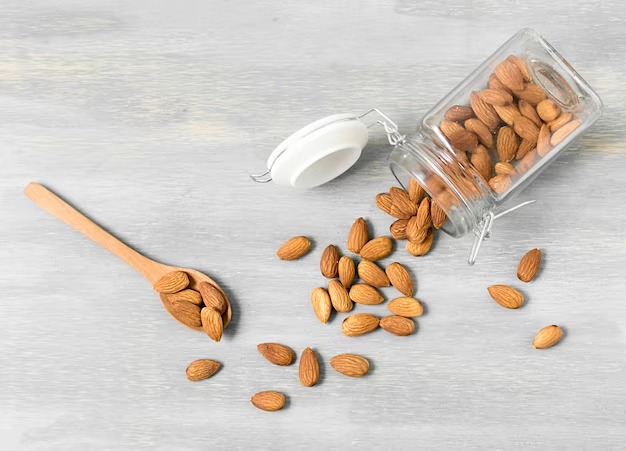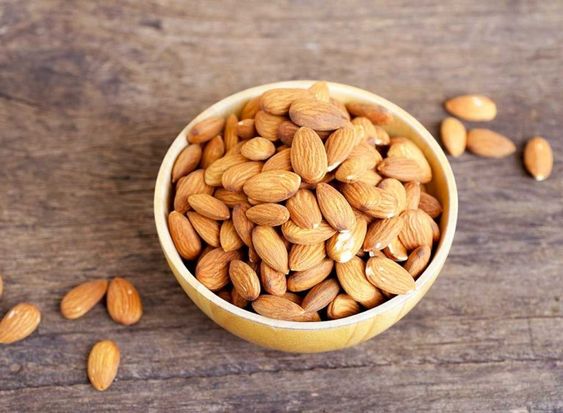Welcome to the nuttiest exploration of diabetes management, you’ll ever read!
Diabetes—a real pain in the pancreas, right? But fear not, because we’re about to embark on a delicious journey that just might make living with diabetes a bit sweeter (pun intended).
Diabetes Decoded
First things first, let’s talk diabetes. It’s like that unexpected guest who overstays their welcome at the body’s house. Diabetes comes in different flavors, but essentially, it messes with your blood sugar levels. Maintaining those sugar levels is like walking on a tightrope, and sometimes, the rope feels more like spaghetti.
Almonds: The Unsung Heroes

Now, enter almonds—tiny, unassuming nuts that pack a nutritional punch like they’re training for a heavyweight championship. While they may not have capes, almonds are superheroes in the world of nutrition. We’re about to spill the beans, or in this case, nuts, on how they can play a starring role in your diabetes-friendly diet.
So, grab your almonds, and let’s dive into a crunchy, nutty world where diabetes meets its match!
Also Read: Batman Workout
Understanding Diabetes
Before we go nuts over almonds, let’s demystify the diabetes drama.
Diabetes Demystified
Diabetes isn’t just a one-size-fits-all condition; it’s more like a choose-your-own-adventure book. There are different types, like Type 1 and Type 2. Think of them as two distant cousins with similar last names but very different personalities.
- Type 1 Diabetes: It’s like an uninvited guest crashing the insulin party. The immune system gets a little too rowdy and decides to trash the pancreas, leaving it unable to produce insulin, the blood sugar bouncer.
- Type 2 Diabetes: Here, it’s more about insulin resistance – the body’s cells turn into sugar skeptics and refuse to let glucose in. It’s like they put up a “No Glucose Allowed” sign.
Sugar Shenanigans
So, why all this fuss about blood sugar? Well, imagine your body is a car, and glucose is the fuel. Too much sugar, and you’re revving the engine on a race track; too little, and you’re stuck on the side of the road with an empty tank. Managing blood sugar is like finding that perfect balance between a leisurely cruise and a thrilling race.
Why It Matters
Diabetes isn’t just about mood swings in your blood sugar rollercoaster – it can lead to some serious health issues. We’re talking about heart disease, kidney problems, and eye troubles, among others. So, keeping those sugar levels in check isn’t just a suggestion; it’s a golden rule for the “Diabetes Club.”
Now that we’ve deciphered the diabetes code, let’s see how almonds come to the rescue!
Almonds: A Nutritional Powerhouse
Hold on to your taste buds; we’re about to dive into the world of almonds, the unsung heroes of the snack universe!
Nutrition in Every Crunch
Almonds may be small, but they’re big on the nutritional stage. These little wonders are packed with goodies your body craves.
- Vitamins Galore: Almonds are like a vitamin store on a shelf. They’ve got vitamin E, which is like the superhero of antioxidants, battling those nasty free radicals. Plus, there’s a dash of manganese to keep your bones and metabolism happy.
- Protein Power: Almonds don’t just bring the crunch; they bring the muscle too. They’re secretly loaded with protein, making them the MVP of nuts.
- Fiber Fix: Feeling a bit backed up? Almonds got you covered! With their fiber content, they’re like the gentle nudge your digestive system needs.
- Healthy Fat Fantasy: Don’t worry; we’re not talking about greasy junk food fat. Almonds boast the good kind – monounsaturated fat, the same one you hear about in olive oil. It’s like the James Bond of fats, suave and heart-healthy.
The Protein Jedi
If almonds were characters in a sci-fi movie, they’d be the Jedi of the protein world. They’re not just good; they’re exceptional, especially when you consider they come from a nut!
Fiber: The Body’s BFF
Think of fiber as your digestive system’s best friend forever. It keeps things moving smoothly, preventing any traffic jams in your gut. And almonds are like the invitation to that fiber party.
Now that we’ve uncovered the treasure trove of almond nutrition, let’s see how they play the sugar-regulating game!
Also Read: Worst Diets
Almonds and Blood Sugar
Now, let’s get into the real juicy stuff – how almonds play the sugar game, and trust us, they’re no rookies!
The Sugar Rollercoaster
Picture this: You just devoured a sugary treat, and your blood sugar is spiking like a rollercoaster on caffeine. But guess who rides to the rescue? Almonds!
Almonds vs. Fasting Insulin and Glucose
In one corner, we have almonds, the mighty nut, and in the other corner, we have the sneaky duo – fasting insulin and glucose levels. So, what happened when they battled it out in a scientific showdown?
- Study Alert!: Back in 2011, some genius researchers found that folks who munched on about 45 almonds (that’s like the snack gold standard) experienced lower fasting insulin and glucose levels. Yes, you read that right – almonds were the champs!
No Extra Calories Required
Here’s the twist: the participants didn’t magically become calorie wizards. They just adjusted their overall intake to accommodate those 45 almonds. So, no extra calories to worry about!
Prediabetes, Meet Almonds
But wait, there’s more! In 2010, another group of scientists discovered that almonds might just be the prediabetes superhero we’ve all been waiting for. They found that almonds could boost insulin sensitivity, which is like giving prediabetes a run for its money.
So, when it comes to blood sugar, almonds aren’t playing games. They’re out there in the scientific arena, showing those glucose levels who’s boss!
Now, let’s explore how almonds and magnesium join forces to make your health even better.
Almonds and Magnesium
Hold onto your hats, because we’re diving into the superhero team-up of the century: Almonds and Magnesium!
The Mysterious Mineral: Magnesium
Let’s start with the star of the show, magnesium. It’s like the secret agent of the mineral world, quietly doing its job to keep you healthy. But what’s its role in this diabetes and almond adventure?
Magnesium and Diabetes Risk
Well, some brilliant minds in lab coats (aka scientists) have discovered a fascinating connection. You see, folks with low magnesium levels might have a higher risk of developing type 2 diabetes. Yikes, right?
The Great Sugar Robbery
Here’s the deal: If your blood sugar is on a wild ride, it can lead to magnesium making a quick exit via your urine. It’s like a sugar heist, and magnesium is the stolen treasure.
Almonds to the Rescue, Again!
But hold on to your almonds! Because guess what’s packed with magnesium? That’s right, our trusty almonds. They’re like the caped crusaders that swoop in to save the day, preventing magnesium deficiency.
So, there you have it, magnesium and almonds – an unlikely but powerful duo in the fight against diabetes. But we’re not done yet; next, we’ll explore how almonds can give your heart some extra love.
Also Read: Dips
Almonds and Heart Health
Now, let’s chat about something we all have a soft spot for – our hearts. And yes, they have a say in this whole diabetes and almond tango too!
Diabetes and the Heart Tango
So, picture this: You have diabetes, and your heart might be feeling a bit jittery. It turns out that people with diabetes often have a higher risk of heart disease. Not the best dance partner, right?
Meet the Heart’s Best Friend: Monounsaturated Fat
But wait, here comes almonds to the rescue again! They’re like the friend who’s always got your back. Almonds are packed with something called monounsaturated fat. It might sound fancy, but trust us, it’s the good kind of fat.
The Olive Oil Connection
In fact, this monounsaturated fat is the same heart-healthy stuff you hear about in olive oil. So, you can basically think of almonds as tiny bottles of heart-healthy olive oil. Handy, right?
Love Without the Calories
But here’s the kicker – nuts are usually high in calories, but they play a sneaky trick on your appetite. They leave you feeling full and satisfied, so you’re less likely to pig out on unhealthy snacks. It’s like they’re saying, “Love me, but don’t overdo it.”
So, there you have it, folks. Almonds, with their monounsaturated fat, are like the wingman for your heart in this wild diabetes journey. Stay tuned because we’ll reveal how many almonds you should have for maximum benefit – hint, it’s not enough to fill a swimming pool!
Proper Portion Control
Alright, folks, let’s dive into the age-old question: how many almonds should you munch on without turning into an almond yourself?
The Magical Number: 23
The answer is simple – 23 almonds. That’s the magic number! You see, almonds come in different shapes and sizes, but this is the sweet spot for a single serving. It’s like nature’s way of saying, “Here’s a tasty snack, but don’t go nuts!”
The Almond Containment Strategy
Now, let’s talk strategy. To avoid mindlessly chomping through your almond stash, try this neat trick – portion them out into small containers or those fancy plastic bags. This way, you won’t accidentally eat the entire almond kingdom in one sitting.
Single-Serve Heaven
And if you’re the grab-and-go type, you’re in luck! Some clever companies sell almonds in single-serving packages. It’s like they knew we needed a little help in the self-control department.
Versatility, Baby
But wait, there’s more! Almonds are like the chameleons of the snack world. You can sprinkle them on your cereal, spread almond butter on your toast, or toss them into your morning smoothie. Feeling adventurous? How about almonds in your salads, stir-fries, or even your rice dishes? And don’t forget dessert – almonds can be the crunchy stars on your frozen yogurt.
So, there you have it, folks. Almonds are versatile, tasty, and, when portioned right, your trusty snack sidekick in the battle against diabetes. Stick to that 23-almond rule, and you’ll be good to go!
Versatility of Almonds
Now that we’ve cracked the almond portion code, let’s talk about how to make these little wonders part of your daily menu without turning every meal into an almond-themed extravaganza.
Breakfast Bonanza
For starters, breakfast! Sprinkle, toss, or just rain down chopped, slivered, or shaved almonds onto your cereal or oatmeal. It’s like giving your morning fuel a crunchy, nutritious makeover. And hey, have you tried almond butter on toast? Or a spoonful in your morning smoothie? Trust us; your taste buds will thank you.
Snack Attack
Need a snack to get through the day? Almonds got your back. Spice up your snack game by adding whole almonds to your trail mix. They’re the perfect partners for your favorite fresh fruit. Or go solo – almonds are pretty tasty on their own and a great way to combat that afternoon slump.
Lunch and Dinner Delights
Let’s move on to lunch and dinner. Spread almond butter on whole-grain, high-fiber bread for a mini-meal win. Or top apple slices with that delightful almond butter. For dinner, almonds can jazz up your salads, stir-fries, or cooked veggies, like green beans amandine. They’re even up for a little stir into your rice or other grain-based side dishes.
Dessert Dreams
And for the grand finale – dessert! Sprinkle those almonds on top of frozen yogurt for an extra crunch that’s oh-so-satisfying. Feeling a bit fancy? Swap out regular flour with almond meal in your baking adventures. Almond-flavored goodies, here we come!
So, there you have it, a whole playbook of almond possibilities! Get creative and add these nutty superstars to your meals and snacks in ways that’ll make your taste buds dance. Just remember, moderation is key. Enjoy the versatility of almonds and savor the deliciousness they bring to the table.
Conclusion.
Alright, folks, let’s wrap up this almond-infused adventure with a sweet conclusion that’s as straightforward as eating a handful of almonds (minus the crunch sound effects).
We’ve dived deep into the world of almonds, exploring their potential as wingmen for your diabetes management journey. These little fellas aren’t just any nuts; they’re the rockstars of the nut universe.
From their impressive nutritional lineup to their blood sugar-stabilizing abilities, almonds are like the superheroes of snacking. They’re packing vitamins, minerals, and healthy fats, all while being your trusty source of protein and fiber.
For those dealing with diabetes, almonds can be your secret weapon. Studies suggest they can help tame the wild glucose and insulin levels, making life a tad easier for you.
And let’s not forget their magnesium mojo. Almonds might just be the knight in shining armor that protects you from the dragon called Type 2 Diabetes.
In the kingdom of hearts (your heart, to be precise), almonds shine as high-society monounsaturated fats. They’re like the fancy olive oil of the nut world, helping you keep heart disease at bay.
Don’t go nuts with the nuts! Remember, portion control is the name of the game. About 23 almonds make a serving, and that’s your golden ticket to nutty goodness without overindulging.
But wait, there’s more! Almonds aren’t just for munching; they’re the Picasso of your plate. Breakfast, snacks, lunch, dinner, dessert – there’s an almond-inspired creation for every meal.
So, what’s the verdict? Should you welcome almonds into your world of diabetes management? Absolutely! They’re like the loyal sidekick you never knew you needed.
In conclusion, embrace the almond’s awesomeness, savor their flavor, and enjoy the journey to better diabetes management. Remember, a handful of almonds a day keeps the doctor away. Or something like that!
Thank you for joining us on this fitness journey! We hope you found our blog insightful and inspiring. Our aim is to provide you with valuable information, expert advice, and motivational content to support you in your wellness endeavors.
Related Post :-
- 1-The Secret to Digestive Wellness: Almond Snacking
- The Almond Benefits: 10 Reasons to Include Them
- The Art of Soaking Almonds: How It Impacts Your Wellness
- Power of Consistence
- Nutritional Gems: A Guide to 10 Healthy Nuts
FAQs about Managing Diabetes with Almonds
How do almonds work their magic on blood sugar?
Almonds are like the cool, calm guardians of your glucose levels. They may reduce the spike in blood sugar and insulin levels after meals, as shown in studies. It's like they have a secret power to keep things in check.
How many almonds should I eat to reap the benefits?
Portion control is key. About 23 almonds make a serving, and that's your golden ticket to nutty goodness without going overboard. Remember, moderation is the name of the game.
Are almonds a good source of magnesium for diabetes management?
Absolutely. Almonds are magnesium champs. This mineral plays a role in reducing the risk of developing Type 2 Diabetes, so munching on almonds is like a mini shield against the diabetes dragon.
Can almonds actually improve heart health for people with diabetes?
Yes, indeed! Almonds contain heart-healthy monounsaturated fats, just like the famous olive oil. This makes them a valuable addition to your diet, especially if you're at risk of heart disease.
Are almonds a high-calorie snack that can lead to weight gain?
Surprisingly, no! Nuts, including almonds, are high in calories, but they don't seem to contribute to increased weight gain when eaten in moderation. They're like the secret agents of healthy snacking.
Can I get creative with almonds in my meals?
Absolutely! Almonds are versatile, like the chameleons of the food world. Sprinkle them on cereal, add almond butter to your smoothie, or toss them into salads, stir-fries, and even desserts. The almond world is your oyster.
What's the deal with almond milk and other almond products?
Almond milk, almond butter, flavored almonds – they're all out there. Just keep an eye on added sugars and sodium in some of these products. But if you're creative, you can incorporate them into your diabetes-friendly diet.
Can almonds be part of my daily breakfast routine?
Absolutely! Start your day with a sprinkle of almonds on your cereal or oatmeal. It's like a crunchy, healthy wake-up call that'll have you ready to face the day.
Any parting words of wisdom about almonds and diabetes?
Certainly! Almonds aren't just nuts; they're your allies in the battle against diabetes. Embrace their goodness, stay mindful of portions, and get ready to add a touch of nutty magic to your diabetes management journey.

Meet Pradeep Singh, your go-to guide for all things fitness, health, and motivation. With over 7 years in the field, Pradeep brings a blend of expertise and real-world experience to his writing. From workout tips to healthy living insights, he simplifies complex topics, making fitness accessible for everyone. His authentic approach and genuine passion aim to inspire and support your wellness journey. Get ready to embark on a path to a healthier lifestyle with Pradeep as your trusted companion and motivator.






















